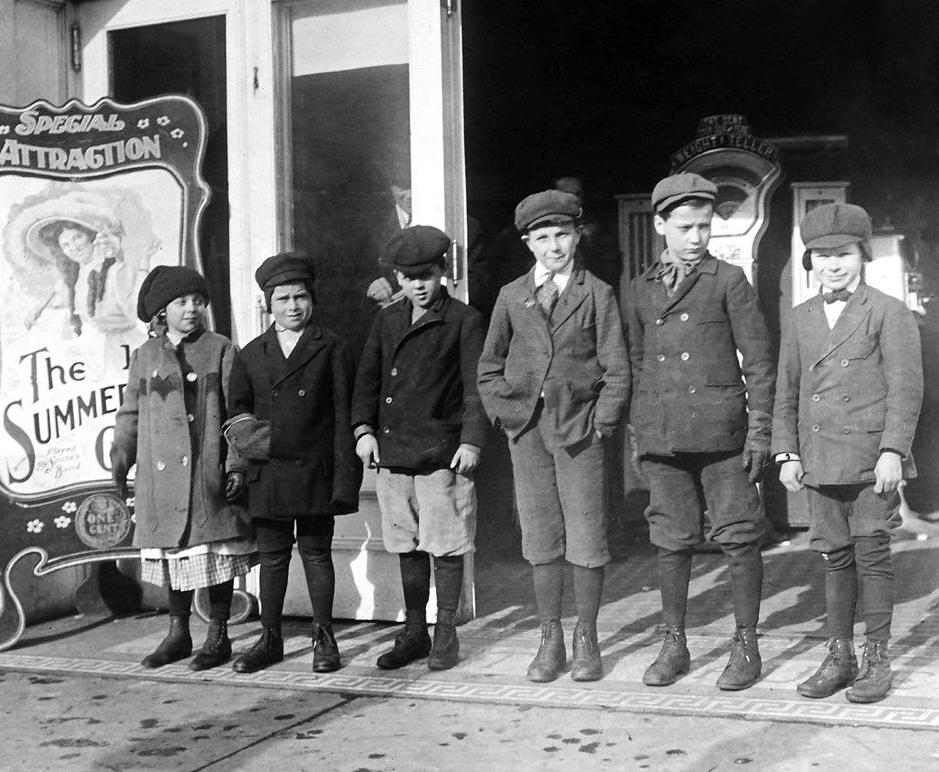
U.S. Outing Activities--Penny Arcades

Figure 1.-This photograph shows a group of children at a penny arcade in Schenectady, New York during 1910. It looks like they are at a movie theater, but they are actually at a penny arcade, just look inside the front door. The billbord is advertising a show on a mechnical viewer. We evnbhave the wheeat sheaf back of the Lincoln penny. At the time movie theaters and feature films were just beginning and Hollywood was not yet making films. Notice the boys are wearing knee pants and knickers. Knickers by 1910 had mostly replaced knickers, but a few younger boys or boys with older brothers were sill wearing knee pants. Also notice the flat caps and the girl's tam.
|
|
The roots of the American penny arcade arose in an America hungry for entertainment. There were theatrical prformances as well as minstral shows. New entetainment venues developed in the late 19th centuries: circuses, dime museums, exposition midways, and amusements parlors. At the turn of the century the penny arcade developed. (The first use of the word has been found in 1903.) The penny arcade was an indoor area with enticing activities. It was free to get in, but most of the devices and booths cost a penny a play. And thnks to America's rising industruial cionomy, there were plnty of jids with pennies. The penny rcades were stocked with coin-operated mechanical games, photography booths, picture shows, and other fun amusements. Developing technolgy from the developing industrial economy made all kind of new amusements possible. New novelties included phonographs, kinetoscopes, and mutoscopes. What was to beome the movies first appeared in penny archades where short clips were viewed. Movie theaters did not appear until there were longer feature films. There were also peep show machines, shooting galleries, grip and strength testers, stationary bicycles, slot machines (where permitted), machines that dispensed fortunes or candy, and other mechanical amusements. And unlike diversions such as theatrical performances, all of this was avilable to kids as long as they had a penny or two. Some of the amusemnts cost more, but there were many penny machines. It was magical for the kids. Adults came as well, probbly men more than women. They could have the brand new experince of listening to recorded sounds and watching moving images. We see the arcades in big cities as well as towns and in tourist areas such s boardwalks. After World War I the novelty begn to wear off. The Movies had develop full-length feature films (1910s), and then the talkies (1929). The arcade owners began to bring in new machines to keep up with the times. David Gottlieb’s Baffle Ball (1931) and Raymond Moloney’s Ballyhoo (1932) introduced pinball to arcades. Kids loved them and not just the kids. And manufacturers began adding refinements such as bumpers, flippers, blinking lights, and enticing artwork. There ere blinking lights, but the action was all mrchnical. Pinball became a part of the American scene for half a century. Othr new activities were a wide range of electromechanical baseball, target shooting, horse racing, shuffle board, and bowling games. In some places they were banned, accusing them as conncted with gambling, organized crime, and delinquency--rather like pool hslls. his continued until the 1990s hn computer video games bcanm to enter the American arcade. The penny attraction had long past.
HBC

Navigate the Boys' Historical Clothing Web Site:
[Return to the Main U.S. outings page]
[Return to the Main circus page]
[Return to the Main U.S. activities page]
[Introduction]
[Activities]
[Biographies]
[Chronology]
[Clothing styles]
[Countries]
[Essays]
[Girls]
[Bibliographies]
[Contributions]
[FAQs]
[Glossaries]
[Images]
[Links]
[Registration]
[Tools]
[ Boys' Clothing Home]
Created: 3:56 PM 10/24/2018
Last updated: 3:56 PM 10/24/2018



